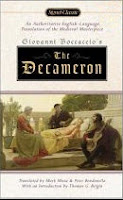Banned Books Challenge #1
 This classic collection of fifteenth-century tales is set during an outbreak of the Black Death. Ten young friends choose to flee Florence for the relative safety of the countryside, where they move between villas and try to forget the horror they have left behind. To entertain themselves in the afternoons, they decide to each tell a tale a day, with one of their number reigning over the others as king or queen each day and setting the theme for the stories. The resulting one hundred tales cover most of Italy and a number of other countries, and every station of life from the highest to the lowest to the (supposedly) most devout. Lecherous friars, deceitful wives, cunning tricksters, gullible fools, vengeful kings, true lovers, and even a couple of ghosts, populate the pages. And while many of the tales are set at some indeterminate time in the past, Boccaccio’s Introduction paints a vivid picture of contemporary Florentine life in the midst of chaotic death.
This classic collection of fifteenth-century tales is set during an outbreak of the Black Death. Ten young friends choose to flee Florence for the relative safety of the countryside, where they move between villas and try to forget the horror they have left behind. To entertain themselves in the afternoons, they decide to each tell a tale a day, with one of their number reigning over the others as king or queen each day and setting the theme for the stories. The resulting one hundred tales cover most of Italy and a number of other countries, and every station of life from the highest to the lowest to the (supposedly) most devout. Lecherous friars, deceitful wives, cunning tricksters, gullible fools, vengeful kings, true lovers, and even a couple of ghosts, populate the pages. And while many of the tales are set at some indeterminate time in the past, Boccaccio’s Introduction paints a vivid picture of contemporary Florentine life in the midst of chaotic death.
It’s impossible not to compare the Decameron to Chaucer’s Canterbury Tales, and the Decameron wins hands down. Although the book itself is long, the stories are generally short; much more so than Chaucer’s. And being written in prose they are much easier to read. Boccaccio also doesn’t go in for the tedious morality tales that Chaucer included. The comparison was most striking during four tales virtually identical to Chaucer’s Reeve’s, Shipman’s, Franklin’s, and Clerk’s Tales. The days all follow the same formula, but some variety is added with outings in the countryside, a servants’ spat, and several distinct personalities among the storytellers: sharp-tongued Elisa, brooding Filostrato, clownish Dioneo.
I read this as part of the Banned Books Challenge, and I realised just why it had been banned when I reached tale 4 of day 1. It was about a monk and his abbot - both of whom seduced the same girl. And that set the tone for much of the next several days, and a good deal of the rest of the book. The clergy were not portrayed in a flattering light; in certain times and places that alone would have gotten it on the banned list. And then there was the sex, including a group of nuns all sharing the gardener, a wife sleeping with another man as revenge for her husband doing the same thing, and a cosy spot of spouse-swapping. After three days it began to get rather tiresome; was that all he could write about? It was also irritating, from a modern perspective, to see the number of female characters apparently quite happy to sleep with whichever man had captured them. Day four, with Filostrato in charge and calling for decidedly downbeat topics, was a refreshing change. From there the subject-matter became more balanced. In spite of these few flaws, it is undoubtedly one of the great literary works of all time and a must-read. No matter how much time you have, or what you feel like reading, there will be something here to suit.
Rating: A-

















I am adding this straight to my bookmooch list! For some reason, I've always been interested in the Black Plague.
ReplyDeleteA good book on the topic is The Return of the Black Death by Susan Scott and Christopher Duncan, which I read last year. It's a history of the Black Death, and a thorough overview of the authors' theory that it was in fact not bubonic plague but something else. I found it fascinating, but my mother thought I was weird :-)
ReplyDeleteGreat review! Hope you don't mind me linking it on my own Decameron review :)
ReplyDeleteI love the broad focus of your blog, and I'm a new follower, provided that the current weirdness with a lot of GFC widgets hasn't thwarted my attempt!